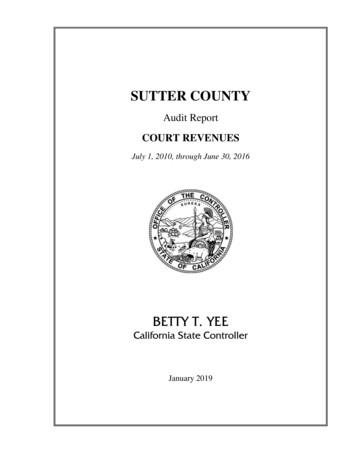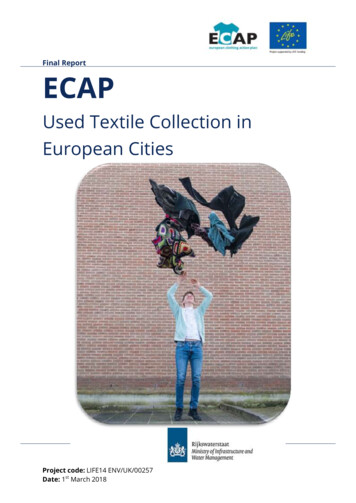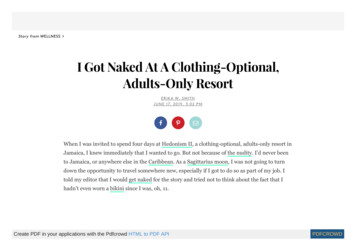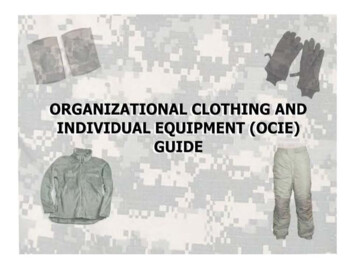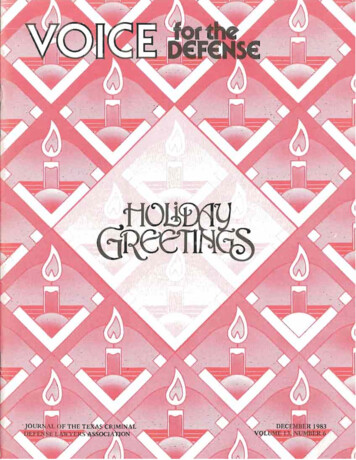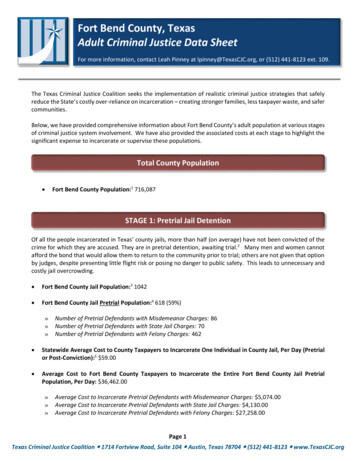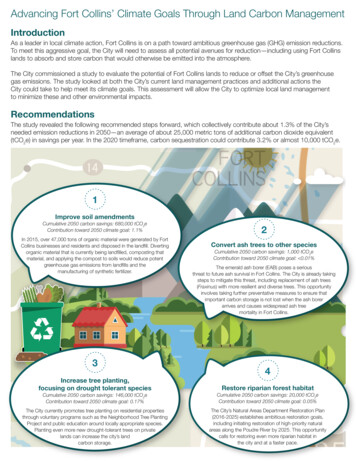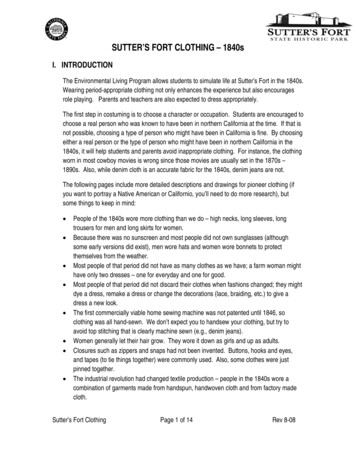
Transcription
SUTTER’S FORT CLOTHING – 1840sI. INTRODUCTIONThe Environmental Living Program allows students to simulate life at Sutter’s Fort in the 1840s.Wearing period-appropriate clothing not only enhances the experience but also encouragesrole playing. Parents and teachers are also expected to dress appropriately.The first step in costuming is to choose a character or occupation. Students are encouraged tochoose a real person who was known to have been in northern California at the time. If that isnot possible, choosing a type of person who might have been in California is fine. By choosingeither a real person or the type of person who might have been in northern California in the1840s, it will help students and parents avoid inappropriate clothing. For instance, the clothingworn in most cowboy movies is wrong since those movies are usually set in the 1870s –1890s. Also, while denim cloth is an accurate fabric for the 1840s, denim jeans are not.The following pages include more detailed descriptions and drawings for pioneer clothing (ifyou want to portray a Native American or Californio, you’ll need to do more research), butsome things to keep in mind: People of the 1840s wore more clothing than we do – high necks, long sleeves, longtrousers for men and long skirts for women.Because there was no sunscreen and most people did not own sunglasses (althoughsome early versions did exist), men wore hats and women wore bonnets to protectthemselves from the weather.Most people of that period did not have as many clothes as we have; a farm woman mighthave only two dresses – one for everyday and one for good.Most people of that period did not discard their clothes when fashions changed; they mightdye a dress, remake a dress or change the decorations (lace, braiding, etc.) to give adress a new look.The first commercially viable home sewing machine was not patented until 1846, soclothing was all hand-sewn. We don’t expect you to handsew your clothing, but try toavoid top stitching that is clearly machine sewn (e.g., denim jeans).Women generally let their hair grow. They wore it down as girls and up as adults.Closures such as zippers and snaps had not been invented. Buttons, hooks and eyes,and tapes (to tie things together) were commonly used. Also, some clothes were justpinned together.The industrial revolution had changed textile production – people in the 1840s wore acombination of garments made from handspun, handwoven cloth and from factory madecloth.Sutter’s Fort ClothingPage 1 of 14Rev 8-08
II. PIONEER CLOTHING - MENPantaloons ortrowsersLoose fitting trousers of wool or cotton, button closures, generally indark colors such as brown, gray and black.ShirtsLoose fitting with dropped shoulders, opening only part way in front.Often checked, plaid or dyed dark colors such as green, blue or red.Generally cotton or linen, but wool shirts were worn in cold weather.VestsCommonly worn. Didn’t necessarily match either trousers or coats.Coats or serapesBoth were worn in California. Coats were similar to those worn today,although they appear baggier. Some coats had collars and lapels andsome were collarless.HatsLarge brimmed felt hats were usually worn. Men shaped the crown tosuit themselves. Some wore cotton or silk bandannas under their hatsin the Californio style.BootsMade from heavy leather with square toes. Turned down tops werecommon. (Pointed-toe cowboy boots are 30 years in the future.)BoysFrom infancy to toddler (until potty trained) – boys wore dresses.After that, some wore short pants, especially in the summer, until theywere about eight. After that they generally dressed like their fathers.III. PIONEER CLOTHING - WOMENDresses ApronsSutter’s Fort ClothingSnug bodice, full skirt, long semi-fitted sleeves.Bodice and skirt might be separate garments or sewn together.Might open in the back or the front – closed with buttons, hooksand eyes, or pins (front closing only).Skirt length varied – girls wore mid-calf length, city women woreankle length, working country women sometimes wore skirtsslightly shorter than ankle length because they had to navigatemuddy farmyards.Often cotton or linen in the summer and wool in the winter. Wellto-do women owned dresses made of luxury fabrics such as silk.Solid colors, checks, stripes, plaids or prints were all common.Dark colors such as dark brown and blue were favored becausethey did not show the dirt as quickly as lighter colors.Separate collars and cuffs might also be worn.Worn with one or more petticoats to give the skirt some volume.Commonly worn. Both skirt-only aprons and pinafore aprons (with littlebibs pinned to the dress bodice) were worn.Page 2 of 14Rev 8-08
Scarves or shawlsWool shawls were commonly worn for warmth when a coat was notnecessary. Some women also wore cotton or linen neck scarves.BonnetsOutdoors, women generally wore bonnets to protect themselves fromthe weather. Both fabric and woven straw bonnets were common.Women with more money might also purchase felt bonnets.Day CapsSome women also wore day caps – generally of white cotton or linen.These were close fitting caps that were worn indoors. Bonnets wereplaced over the day cap when the woman went outside. By the 1840s,day caps were becoming slightly old fashioned. However, this is ahandy way to hide modern short hair.ShoesCommonly flat soled, tie up, in brown or black leather. Some womenhad rawhide boots made for the journey west.GirlsLittle girls generally wore mid-calf-length unfitted dresses. By theirmid-teens, they dressed like their mothers.IV. CLOSE ENOUGH . . .Men Women Sutter’s Fort ClothingCover your modern trousers with a long shirt to hide thezippers, pockets and belt loops.Over your shirt wear a leather belt or fabric sash and tie ona pouch.Square toed boots or moccasins.Wide brimmed felt hat.Fly-front trousers can also be disguised by sewing buttonson top.Vests, scarves and suspenders are appropriate.An old wool blanket can be made into a serape.Long, full skirtHigh necked, long sleeved blouseApronFabric bonnetSquare toed boots, moccasins or flat black tie-upShawl for cold weather – you can make one out of a squarepiece of fabric folded into a triangle.Cape for cold weather – any length from waist to ankle isappropriate. Materials may include blanket, corduroy,velvet, velveteen, wool.Page 3 of 14Rev 8-08
Cold weather gearThe Fort gets very cold and wet in the winter. Under yourcostume, you can wear thermal underwear. Bring extra pairs ofsocks for yourself and your children to change into. Nylonponchos and umbrellas can be used on nightwatch.CarriersRemember journals, pencils, cups, trade store purchases, craftitems, etc. have to be carried somehow. Baskets, pouches,and canvas bags work well.FIRE SAFETYIf you will be working around an open fire, consider yourcostume carefully. Wool is safest. Cotton and linen burn like grass unless they have beentreated. Polyester will melt onto your skin. Tight sleeves are safer than loose sleeves. Women can partially protect themselves by wearing along full wool apron over their skirts. If the worst happens, remember what you teach yourchildren – stop – drop – roll –If your’re planning to sewFabrics – cotton, linen or wool in plain weave, twill or corduroyare all fine. Solid colors, checks, stripes and plaids are fine.Calicos with small prints and limited colors are also fine – e.g.,ground color plus not more than 4 other colors.Closures – hooks and eyes, buttons of metal, bone, mother ofpearl, horn, leather, wood, crocheted thread.Patterns – some currently available Sutter’s Fort Trade Store carries several patterns Folkwear – http://folkwear.com/o Kinsale Cloak (# 207, 208)o Missouri River Boatman’s Shirt (#204) Past Patterns - http://www.pastpatterns.com/o Fan front bodice and skirt (#800, 801)o Small fall trowsers (#008)o Two mid-19th century shirts (#007)o Several of the ladies underwear patterns are ok Simplicity - http://www.simplicity.com/o Pioneer dress, bonnet, apron (#3723) – just usehooks and eyes on back seam in place of zipper McCalls - http://www.mccall.com/o Early American (#4547, 4548)Sutter’s Fort ClothingPage 4 of 14Rev 8-08
The following drawings are from the Sutter’s Fort State Historic Park Costume Manual, AGuide to the Clothing Worn in California and the Far West, CA 1845, Text and Illustration byDavid W. Rickman.Sutter’s Fort GarrisonBodyguard in Russian UniformSutter’s Fort ClothingAfter Issue of Naval SuppliesPage 5 of 14Rev 8-08
Captain SutterAmerican or European SailorIn “Military” AttireSutter’s Fort ClothingWork ClothingPage 6 of 14Rev 8-08
Presidial SoldiersCampaign UniformsCavalrymanSutter’s Fort ClothingOfficerPage 7 of 14Rev 8-08
Californio ManBest ClothesSutter’s Fort ClothingWork and Travel ClothesPage 8 of 14Rev 8-08
Californio WomanBest ClothesSutter’s Fort ClothingWork and Travel ClothesPage 9 of 14Rev 8-08
Emigrant ManSutter’s Fort ClothingPage 10 of 14Rev 8-08
Emigrant WomanBest ClothesSutter’s Fort ClothingPage 11 of 14Rev 8-08
Fur TrapperBest ClothesSutter’s Fort ClothingWork and Travel ClothesPage 12 of 14Rev 8-08
Some Hairstyles for American, European and Californio WomenSutter’s Fort ClothingPage 13 of 14Rev 8-08
Day Caps and BonnetsSutter’s Fort ClothingPage 14 of 14Rev 8-08
Early American (#4547, 4548) Sutter’s Fort Clothing Page 4 of 14 Rev 8-08. The following drawings are from the . Sutter’s Fort State Historic Park Costume Manual, A Guide to the Clothing W
